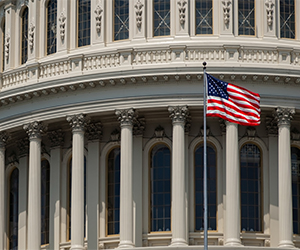
The expansive Coronavirus Aid, Relief, and Economic Security Act (CARES Act) includes numerous employment-related provisions, including expansion of unemployment benefits, special rules regarding various types of retirement plans and arrangements, and employer federal payroll taxes. Read on for a summary of some of the most significant provisions.
Expansion of unemployment benefits – Additional and enhanced unemployment compensation will be provided.
Pandemic Unemployment Assistance
Additional unemployment benefit assistance will be available to a “covered individual” for up to 39 weeks of unemployment, partial unemployment, or inability to work caused by COVID-19. To qualify, the individual must not be entitled to any other federal or state unemployment compensation or waiting period credit.
The assistance will be available for the period beginning on or after Jan. 27, 2020, and ending on or before Dec. 31, 2020. (The Secretary of Labor is to establish a process for making this assistance available for weeks beginning on or after Jan. 27, 2020, and before the date of enactment, March 27, 2020.) Regardless of state law, no waiting period will apply to the receipt of these benefits. The assistance is limited to a maximum of 39 weeks, which is to include any week for which the individual received regular compensation or extended benefits under any federal or state law. (Following enactment, if the duration of extended benefits is extended, the 39-week limitation will be extended by the number of weeks of the extension.) The states will administer and pay these benefits with funds provided by the federal government.
The assistance amount for each week is the sum of 1) the weekly benefit amount authorized under the unemployment compensation law of the state where the covered individual was employed (but not less than the benefit that would be provided under state law for a week of total unemployment), plus 2) $600. The benefit for a covered individual who is self-employed or who would otherwise not qualify for unemployment compensation under state law is 1) the benefit that would be provided under state law for a week of total unemployment plus 2) $600.
For this purpose, a “covered employee” is an individual who “is not eligible for regular compensation or extended benefits under state or federal law,” including an individual who has exhausted all rights to regular unemployment or extended benefits under state or federal law. The Act states that to qualify, the individual will be required to provide self-certification of being otherwise able to work and available for work within the meaning of applicable state law, but unemployed, partially unemployed, or unable or unavailable to work because the individual:
(i) has been diagnosed with COVID-19, or is experiencing symptoms of COVID-19 and seeking a medical diagnosis;
(ii) has a household member who has been diagnosed with COVID-19;
(iii) is providing care for a family or household member who has been diagnosed with COVID-19;
(iv) has a child (or other household member for which the individual has primary caregiving responsibility) who is unable to attend school or another facility that is closed as a direct result of the COVID-19 public health emergency, and such school or facility is required for the individual to work;
(v) is unable to reach the individual’s place of employment because of a quarantine imposed as a direct result of the outbreak;
(vi) is unable to reach their place of employment because they have been advised by a health care provider to self-quarantine due to concerns related to COVID-19;
(vii) was scheduled to commence employment and does not have a job or is unable to reach it as a direct result of the outbreak;
(viii) has become “the breadwinner or major support for a household” because the head of the household has died as a direct result of COVID-19;
(ix) is required to quit their job as a direct result of COVID-19;
(x) has experienced the closing of their place of employment as a direct result of the COVID-19 public health emergency;
(xi) meets any additional criteria established by the Secretary of Labor for unemployment assistance; or
(xii) is self-employed, is seeking part-time employment (if the state allows an individual seeking part-time employment to receive regular unemployment compensation), does not have sufficient work history, or otherwise would not qualify for regular unemployment under state or federal law and becomes unemployed or cannot find work.
A “covered individual” does not include an individual who A) can telework with pay or B) is receiving paid sick leave or other paid leave benefits.
Emergency increase of unemployment compensation benefits
Regular state law unemployment compensation (including dependents’ allowances) will be paid to an individual for any week for which the individual would otherwise be entitled to it, equal to the sum of 1) the weekly benefit amount authorized under the unemployment compensation law of the state where the covered individual was employed (but not less than the benefit that would be provided under state law for a week of total unemployment), plus 2) $600 (“Federal Pandemic Unemployment Compensation”).
Temporary full federal funding of the first week of compensable regular unemployment for states with no waiting week
Any state that provides unemployment benefits to individuals for their first week of regular unemployment (i.e., does not impose a “waiting week” requirement) may enter an agreement with the Secretary of Labor for the federal government to fully reimburse the state for the total amount paid for that week, plus any additional administrative expenses incurred by the state (as determined by the Secretary of Labor). The agreement can run through Dec. 31, 2020.
Pandemic Emergency Unemployment Compensation
For the period ending on or before Dec. 31, 2020, a participating state will make payments of pandemic emergency unemployment compensation for up to 13 weeks to individuals who:
1) Have exhausted all rights to regular unemployment compensation under state or federal law with respect to a benefit year (excluding any benefit year that ended before July 1, 2019);
2) Have no rights to regular unemployment compensation with respect to a week under state unemployment compensation law or to compensation under any other federal law;
3) Are not receiving compensation with respect to that week under Canadian unemployment compensation law; and
4) Are able and available to work, and actively seeking work, with specified “actively seeking work” requirements.
The benefit amount will be equal to the amount of the regular unemployment compensation (including dependents’ allowances) payable to the individual during the individual’s benefit year under the state law for a week of total unemployment, plus the additional $600 (through July 31, 2020).
Special rules for IRAs and certain retirement plans – Increased access to retirement plan and IRA assets, waiver of the required minimum distribution requirements for 2020, and more time for employers to meet their pension plan funding obligations are provided.
Tax-favored withdrawals
The 10% excise tax under IRC Section 72(t) on taxable IRA and tax-qualified retirement plan distributions (for retirement plan purposes, as a “hardship distribution”) received by an individual younger than 59.5 on or after Jan. 1, 2020, and before Dec. 31, 2020, will not apply to any “coronavirus-related distribution” of up to $100,000. The exception will apply solely to an individual 1) who or whose spouse or dependent is diagnosed with the virus SARS-CoV-2 or the disease COVID-19 per a test approved by the Centers for Disease Control and Prevention, or 2) who due to SARS-CoV-2 or COVID-19 experiences adverse financial consequences as a result of being quarantined, furloughed, or laid off or having work hours reduced; being unable to work due to a lack of child care; closing or reducing hours of a business owned or operated by the individual; or for other factors determined by the Secretary of the Treasury. A retirement plan administrator can rely on an employee’s certification that the above requirements have been met.
Any individual who receives a coronavirus-related distribution will be able to repay part or all of the distribution by making, at any time during the three-year period beginning on the day after the date of the distribution, one or more contributions to an eligible retirement plan that accepts rollover contributions, for a total amount no greater than the amount of the coronavirus-related distribution. The individual will avoid taxation on the receipt of the distribution by its being treated as having been rolled over per a timely direct rollover.
Unless the taxpayer elects not to have it apply for any tax year, any amount of a coronavirus-related distribution that is taxable may be included in income ratably over the three-year period beginning with the tax year in which the distribution occurs.
Increased amount of maximum tax-qualified retirement plan loans
For the 180-day period following enactment, the existing “lesser of $50,000 or one-half of the present value of the participant’s nonforfeitable accrued benefit” tax-qualified retirement plan loan limit is increased to the lesser of $100,000 or the full present value of the benefit for a loan to an individual 1) who or whose spouse or dependent is diagnosed with the virus SARS-CoV-2 or with the disease COVID-19 per a test approved by the Centers for Disease Control and Prevention, or 2) who due to SARS-CoV-2 or COVID-19 experiences adverse financial consequences as a result of being quarantined, furloughed, or laid off or having work hours reduced; being unable to work due to a lack of child care; closing or reducing hours of a business owned or operated by the individual; or for other factors determined by the Secretary of the Treasury. If any such individual has an outstanding plan loan (other than a home loan) on or after the enactment date, where any repayment due date occurs between the enactment date and Dec. 31, 2020, the due date will be delayed for one year.
Temporary waiver of required minimum distribution rules
The required minimum distribution rules are suspended for calendar year 2020 for IRAs, tax-qualified retirement plans, IRC Section 403(a) individual retirement annuities, IRC Section 403(b) annuity plans, and governmental IRC Section 457(b) eligible deferred compensation plans (not applicable to Section 457(b) plans maintained by non-government tax-exempt entities). Consequently, any required minimum distribution required to be made from any of these plans/IRAs in calendar year 2020, including a required minimum distribution for 2019 that was otherwise due by April 1, 2020, will be waived.
Additional time to satisfy funding requirements for a tax-qualified single-employer pension plan
An otherwise due date in calendar year 2020 for an employer to make contributions to a tax-qualified single-employer defined benefit pension plan for purposes of satisfying the minimum funding requirements is extended to Jan. 1, 2021. Interest will accrue on the unpaid required contribution amount until the contribution is made.
Employer Payroll Taxes – Certain employers will be eligible for a federal payroll tax credit and/or deferral of the payment of the employer portion of their federal Social Security payroll tax obligations.
Employee retention credit for employers subject to closure due to COVID-19 or having experienced a 50% reduction of gross receipts
The Act provides a refundable payroll tax credit equal to 50% of the amount of wages paid or incurred from March 13, 2020 through Dec. 31, 2020, applicable to the employer portion of the federal Social Security tax. The credit is claimed using IRS Form 7200 (Advance of Employer Credit Due to COVID-19). The credit is available to employers for any calendar quarter 1) where the employer’s operations were fully or partially suspended due to a COVID-19-related shut-down order, or (2) beginning with a 2020 calendar quarter for which the employer’s gross receipts declined by more than 50% when compared to the same quarter in 2019 and ending with a 2020 calendar quarter for which the employer’s gross receipts are greater than 80% of its gross receipts for the same calendar quarter in 2019.
The credit is based on “qualified wages” paid to the employee. For employers with more than 100 full-time employees, “qualified wages” are wages paid to employees only when they are not providing services due to the COVID-19-related circumstances described above. For eligible employers with 100 or fewer full-time employees, all employee wages are “qualified wages” for purposes of the credit, regardless of whether the employer is open for business or subject to a shut-down order.
The credit is provided for the first $10,000 of compensation, including health benefits, paid to an eligible employee for all applicable calendar quarters. The credit for a calendar quarter is limited to the employer portion of the federal Social Security payroll tax on the “qualified wages.”
Update: Since this writing, the IRS has issued more detailed guidance on the Employee Retention Credit. Read our overview.
To prevent employers from receiving a double benefit for paying the same wages, an employer cannot receive an employee retention credit for the same wages for which it receives a credit 1) under IRC Section 45S, for providing paid leave under the Family and Medical Leave Act of 1993; 2) for making mandatory coronavirus-related sick pay and expanded family emergency leave pay under the Families First Coronavirus Response Act; or 3) under IRC Section 51, as a “Work Opportunity Tax Credit.” In addition, the credit will not be available to any taxpayer that has received a loan under the Paycheck Protection Program.
Delay of payment of employer portion of federal Social Security payroll tax
For the period beginning on the enactment date and ending before Jan. 1, 2021 (except for an employer that has had indebtedness forgiven under the Paycheck Protection Program, other than a self-employed individual), otherwise required tax deposits for the employer portion of the federal Social Security tax will be considered timely if 50% of the required deposits are made by Dec. 31, 2021, and the remaining 50% is deposited by Dec. 31, 2022. For self-employed individuals, the deposit deferral also extends to 50% of the Social Security potion of SECA taxes and related estimated tax payment obligations. If an employer utilizes a payroll agent or certified professional employer organization for federal payroll tax deposit purposes, and directs the agent or organization to defer the deposit of the employer portion of its federal Social Security tax, the employer will be solely liable for the deposits being made under this provision on a timely basis.
Other miscellaneous changes
Emergency Family and Medical Leave Act Paid Leave for Rehired Employees
Under the Families First Coronavirus Response Act, there is a 30-calendar-day employment requirement for eligibility to receive up to 12 weeks of emergency leave (including reduced pay for up to 10 weeks) where an employee is unable to work or telework from home because the school or place of care for an employee’s child younger than age 18 is closed due to the coronavirus. For an employee who was laid off and then rehired, this service-based eligibility requirement will be met if the employee was laid off no earlier than March 1, 2020, and had worked for the employer for not less than 30 of the last 60 calendar days prior to the layoff.
Nontaxable employer payments of employee student loans
IRC Section 127(c) is amended to provide that prior to Jan. 1, 2021, an employer can make payments of up to $5,250, whether to its employee or to a lender, of principal or interest on any “qualified education loan” (as defined in IRC Section 221(d)(1)) incurred by the employee for the employee’s education.
What does CohnReznick think?
The above-described provisions of the CARES Act will be an important part of the legislative effort to assist employers and their employees in their efforts to survive the economic and personal turmoil they face. The expanded unemployment benefits, enhanced access to retirement funds, employee retention federal payroll tax credits, and deferred payment of federal payroll taxes are designed to provide businesses and individuals with additional funds to help alleviate some of the increased financial burdens they face.
Dana Fried
Contact
Let’s start a conversation about your company’s strategic goals and vision for the future.
Please fill all required fields*
Please verify your information and check to see if all require fields have been filled in.

On-Demand Webinar: Obtaining COVID-19 Financial Relief

On-Demand Webinar: Mitigating Coronavirus Disruption

Coronavirus Resource Center
Related services
Any advice contained in this communication, including attachments and enclosures, is not intended as a thorough, in-depth analysis of specific issues. Nor is it sufficient to avoid tax-related penalties. This has been prepared for information purposes and general guidance only and does not constitute legal or professional advice. You should not act upon the information contained in this publication without obtaining specific professional advice specific to, among other things, your individual facts, circumstances and jurisdiction. No representation or warranty (express or implied) is made as to the accuracy or completeness of the information contained in this publication, and CohnReznick LLP, its partners, employees and agents accept no liability, and disclaim all responsibility, for the consequences of you or anyone else acting, or refraining to act, in reliance on the information contained in this publication or for any decision based on it.














